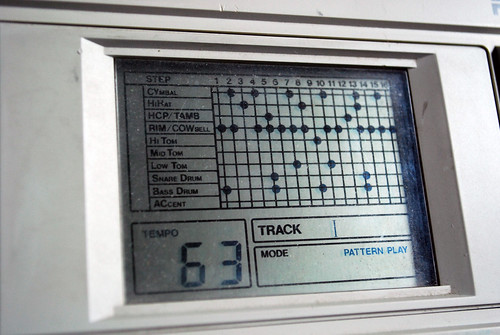When I went back to NYC earlier this year, I got some of my gear from the 80s out of storage. I wish I could say that I had great synths or famous FX and drum machines from that time, but mostly what I found was the cheap stuff I could afford as a youth. If you buy any piece of music gear now you can safely think its going to have some built in sequencing or at least MIDI. In the 80s that just wasnt the case. Pre-MIDI, sequencing was all about voltage control or pulse clocks.
The simplest way to explain a pulse clock is that whenever a clock "tick" occurs, a positive voltage signal is sent from your master clock. Devices which received this signal would move forward one step in their program when a positive voltage was detected on the input. I used to have a Sequential Circuits Pro-One synth which had an internal 16 step sequencer and accepted pulse clock input. I was also lucky enough to have a Roland TR-707 drum machine which would do MIDI and output a pulse clock signal whenever you programmed in a rimshot.
(credit BDU's Flikr stream)
In the photo above, the Pro-One would play a note on beats 1,2,4,5,6,7,8,10,11,13,14,15,16. Since most of the time the down beat is on 1,5,9,13 that would be a very busy synth line even at the slow speed of 63BPM (slower than most roots reggae).
Drum machines generally only had pulse "out", you usually used them as your master clock. If you wanted to sync a drum machine like this to something else you had to do it manually. Even Roland's relatively cheap DR-110 drum machine (the last of their analog drum boxes) has a pulse out. The DR-110 is one of the items from that era that I have and recently I tried to get it to play nicely with some other noisemakers like the Boss PC-2 percussion synth pedal which happens to conveniently have an external input which when it sees a signal it makes sound.
My first attempt is like this:

With the DR-110, every time an accent is programmed in a pattern or if you hit the accent pad while the DR-110 is playing, it sends a positive voltage to the "acc trig out" jack. This signal is enough to make the PC-2 make sound. (Check YouTube for various examples of the PC-2 if you are curious).
Sometime in the last year or so I picked up the Gaken SX-150 Analog Synthesizer kit. Its a very simple synth, but I never really go into using it musically. Recently I remembered that also had an "external source" jack and figured I'd see if it worked as some kind of signal filter or if it was a trigger input. Turns out it is supposed to work as a trigger by doing a voltage to note conversion. I figured I'd try the same trick as above and see what happened.

I patched the trigger out from the DR-110 to the external input of the SX-150 and nothing happened. I tried twiddling with the "balance" and "accent" knobs but still no sound. (On the DR-110, "balance" is like the tone knob on an old tape recorder changing the output from bass to treble, "accent" changes the accent level and does actually change the voltage on the accent out jack.)
Not wanting to give up after seeing people talking about this problem on the web, I figured I'd try a "hotter" signal and rout an auxiliary output from a mixer to the input of the SX-150 like this:

This worked. Sound came out of the SX-150 and changed depending on the level of Aux send fed to it. The result is not very musical but at least its a little something. When I sent it the signal from the DR-110 I get a progression from growl to screech to beep and back. The PC-2 made a growl or a screech depending on how I was twisting the knobs on the PC-2 while I played it. I did try feeding back the Aux send of the SX-150's mixer channel but that just made a nasty screech.
Oh yes, that really is a Radio Shack "Realistic Reverb" from the 80s for that nasty bucket brigade delay sound. Gear fetishists please note, its not worth chasing one of these down, just get the Audio Damage RatShack Reverb plugin instead.




